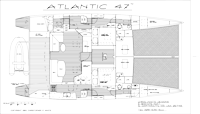June 19,2013
First Voyage
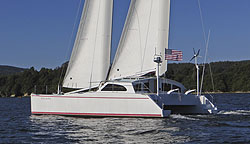 A47 'Pounce' was completed by Alwoplast in Valdivia, Chile in early June 2013. I was there with the owners Thom and Francine Dozier and their crew for the commissioning. After commissioning, they planned to sail north to the Dozier's home on the Chesapeake Bay. I asked if I could join Pounce for the first segment of their long sail toward Panama. Thom was happy to add me to the ranks of his all star crew of Mike, Ann and Larry. Francine would sign on in Florida for the final leg to the Chesapeake.
A47 'Pounce' was completed by Alwoplast in Valdivia, Chile in early June 2013. I was there with the owners Thom and Francine Dozier and their crew for the commissioning. After commissioning, they planned to sail north to the Dozier's home on the Chesapeake Bay. I asked if I could join Pounce for the first segment of their long sail toward Panama. Thom was happy to add me to the ranks of his all star crew of Mike, Ann and Larry. Francine would sign on in Florida for the final leg to the Chesapeake.
Thom Dozier has an extensive history sailing and racing beach cats. He then moved on to larger cruising boats. Mike was a commanding officer in the USCG for many years and now runs a marine engine business. Ann is a critical care nurse and superlative cook, and Larry is the onboard electronics/computer geek. In total there were skills aboard to solve just about any problem and I was very pleased to have the chance to sail with them.
June is late autumn in the southern hemisphere and the weather in Valdivia was not good for anything but ducks and mushrooms. Near constant rain from a series of deep lows coming into Patagonia from the southern ocean slowed the final preparations on 'Pounce'. Moreover, the Chilean Navy had closed all the southern ports including Valdivia due to 10 meter (33') seas offshore and strong Northerly winds. Waiting was our only option.
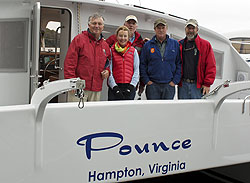 Eventually, boat projects were completed and there was a break in the weather. This promised to be several days of either light or favorable winds before the next low pressure system was forecast to slam into the Andes. From Valdivia you need to sail about 500 miles north to get into a more benign climate where the southerly winds stabilize around a largely stationary high pressure system west of Valparaiso. Once into the high pressure area the winds may be strong but they will be southerly, and there is little risk of severe weather. So the safe way to play the departure in the off season is to get north as fast as possible, motoring if necessary, to get beyond the reach of Southern Ocean storms.
Eventually, boat projects were completed and there was a break in the weather. This promised to be several days of either light or favorable winds before the next low pressure system was forecast to slam into the Andes. From Valdivia you need to sail about 500 miles north to get into a more benign climate where the southerly winds stabilize around a largely stationary high pressure system west of Valparaiso. Once into the high pressure area the winds may be strong but they will be southerly, and there is little risk of severe weather. So the safe way to play the departure in the off season is to get north as fast as possible, motoring if necessary, to get beyond the reach of Southern Ocean storms.
At mid day we motored Pounce out of the river under low overcast and misting rain. An ebb tide and Pounce's 9 knot motoring speed made relatively short work of the 8 miles to open water. Corral Harbor at the mouth of the river was sloppy, with wind and swell against the outgoing tide. Once clear of the river the seas became more regular and we were able to motor sail on course against a light northwesterly breeze until the wind fizzled out completely.
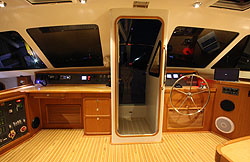 Several hours later the weather started to improve and we could see some red sky beneath the clouds to the west as the sun set. After 12 straight days of rain this was a welcome sight! The Navy forecast had predicted light headwinds for the first day, then a shift to the SW with increased velocity. Along with the wind increase there was a large SW swell from the series of recent storms and that swell was also forecast to grow. We motored through the night making good progress. By midnight we were passing Isla Mocha and the wind had started to shift to the WSW although it was still too light to sail. Intermittent light rain, cold water temperatures and fog made the pilothouse - with the heat running - the place to be for standing watch in comfort.
Several hours later the weather started to improve and we could see some red sky beneath the clouds to the west as the sun set. After 12 straight days of rain this was a welcome sight! The Navy forecast had predicted light headwinds for the first day, then a shift to the SW with increased velocity. Along with the wind increase there was a large SW swell from the series of recent storms and that swell was also forecast to grow. We motored through the night making good progress. By midnight we were passing Isla Mocha and the wind had started to shift to the WSW although it was still too light to sail. Intermittent light rain, cold water temperatures and fog made the pilothouse - with the heat running - the place to be for standing watch in comfort.
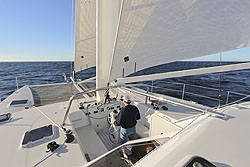 By mid morning the second day there was finally a sailing breeze. We unrolled the two sails, trimmed the mast foils and shut off the engines. Our course was deep off the wind so the sailing was not particularly exciting but we had knocked out 200 miles in the first 24 hours and transited to the edge of the high pressure system where the weather was sure to improve. The sun did appear after it burned off the fog and we had a beautiful sailing afternoon. The widely spaced swells were building in height but did not cause any discomfort. The larger wave sets were over 15' high, consistent with the Navy forecast.
By mid morning the second day there was finally a sailing breeze. We unrolled the two sails, trimmed the mast foils and shut off the engines. Our course was deep off the wind so the sailing was not particularly exciting but we had knocked out 200 miles in the first 24 hours and transited to the edge of the high pressure system where the weather was sure to improve. The sun did appear after it burned off the fog and we had a beautiful sailing afternoon. The widely spaced swells were building in height but did not cause any discomfort. The larger wave sets were over 15' high, consistent with the Navy forecast.
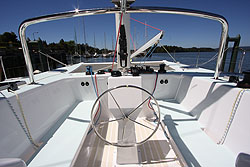 For the first hours we sailed Pounce downwind under a wing and wing configuration. On a run there isn't much difference in speed made good between wing and wing or gybing downwind so we experimented with both. Depending on the wave train(s) often one method is more comfortable than the other and you really just need to try each to see what works best. Wing and wing worked well, although the fore sail is more stable when it's boomed out toward to windward - otherwise it catches the turbulence from the mizzen. The wind was still light, not enough to enable surfing the swells, and we were making 6-7 knots. Both mastfoils were trimmed square to the wind, which seemed the be the right thing to do on a run.
For the first hours we sailed Pounce downwind under a wing and wing configuration. On a run there isn't much difference in speed made good between wing and wing or gybing downwind so we experimented with both. Depending on the wave train(s) often one method is more comfortable than the other and you really just need to try each to see what works best. Wing and wing worked well, although the fore sail is more stable when it's boomed out toward to windward - otherwise it catches the turbulence from the mizzen. The wind was still light, not enough to enable surfing the swells, and we were making 6-7 knots. Both mastfoils were trimmed square to the wind, which seemed the be the right thing to do on a run.
The wind slowly increased as the day progressed. We gybed to port on a deep reach and vanged both sails forward with the foils rotated so that the leeward telltales were streaming. True wind was getting up to 15 kts, the sea was still flat with a long large swell. Pounce liked this and would occasionally catch a wave surfing into the low teens.
Gybing the mastfoil rig is a piece of cake. The sheets are pulled in most of the way, the course changed, sails come over, then the sheets eased and vangs snugged. Self tacking jibs don't slam over the way a large roached mainsail does so the whole exercise is a very low stress event, even in big winds. If it's really blowing hard you can always control the jib boom with the vang/preventer and ease it over slowly but that does not seem to be necessary in winds under 30-35 kts. The foils can be ignored until you are ready to re-trim them. The foil trimming loads are low in the conditions I have seen and it takes little effort to position the foils wherever they need to be.
At this point sailing conditions were still light to moderate, but I was pleasantly surprised and very happy by how absolutely quiet the mastfoil rig is. A conventional catamaran rig, even sailing in light conditions, tends to make lots of squeaks and creaks as the boat rolls in the swell. The high loads on the sheet and vang used to keep the mainsail leech under control (and off the leeward shrouds) stretch and contract the lines on every wave, groaning in rope clutches, squeaking over blocks and winches in addition to the occasional loud crack/snap of upper mainsail battens as the sail snap fills with wind and empties as the boat rolls. In contrast Pounce's MastFoil rig was dead silent. Not a peep! Maybe this sounds like a trivial point but I don't think so; quiet is comfort. And those noises can be signs of excessive wear on sheets, blocks and sails.
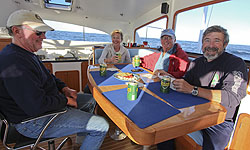 Sunset the second day brought happy hour and a peaceful sit down dinner expertly prepared by Ann. The wind was slowly building so that by 8pm it was time to roll up some sail. Pounce was frequently taking off on a swell, surfing along into the high teens. Catching waves is fun, particularly during daylight for the people awake. It's not as much fun in the dark, especially for crew off watch trying to rest. So I had the honor of stepping out into the cockpit to ease off the mizzen outhaul while my right index finger pushed the furler button to roll up about half of the sail. I doubt if this took 20 seconds. Then back inside where it was warm!
Sunset the second day brought happy hour and a peaceful sit down dinner expertly prepared by Ann. The wind was slowly building so that by 8pm it was time to roll up some sail. Pounce was frequently taking off on a swell, surfing along into the high teens. Catching waves is fun, particularly during daylight for the people awake. It's not as much fun in the dark, especially for crew off watch trying to rest. So I had the honor of stepping out into the cockpit to ease off the mizzen outhaul while my right index finger pushed the furler button to roll up about half of the sail. I doubt if this took 20 seconds. Then back inside where it was warm!
On watch again in the wee hours of morning, sitting with Thom in the pilothouse, the wind and waves increased another notch. Pounce was once again frequently catching waves for long surfing rides. Each time the water noise changed from hiss to roar as her speed increased from 9 to 20+ knots. Okay, time to ratchet back again in the name of comfort. The mizzen foil was trimmed square to the wind so that was an obvious choice for "reefing". Once again I stepped into the cockpit, put the winch handle in the mastfoil rotation control, released the lock and turned the foil (it actually turned itself) into the wind. At that point the foil essentially disappears as far as the wind is concerned as its streamlined shape has 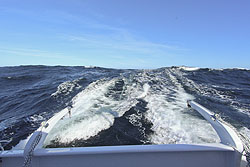 extremely little drag. Thom and I both wondered how much difference that would make as we resumed our comfortable watch keeping seats. Our "sail" reduction was quite significant, cutting Pounce's speed enough so that the surfing was greatly diminished. Not really a surprise, but satisfying to see how quickly the sail area can be changed both up and down by trimming the foils. I don't think it took more than 5 seconds to adjust the mizzen foil.
extremely little drag. Thom and I both wondered how much difference that would make as we resumed our comfortable watch keeping seats. Our "sail" reduction was quite significant, cutting Pounce's speed enough so that the surfing was greatly diminished. Not really a surprise, but satisfying to see how quickly the sail area can be changed both up and down by trimming the foils. I don't think it took more than 5 seconds to adjust the mizzen foil.
The next morning was once again cold and foggy with a thick overcast marine layer. The wind was 25 to 30 kts, still way behind us, with a sizable swell. The day before standing on the house top, the swell would break the horizon. My eye height standing there is almost 15' above the waterline so the swell was somewhat taller than that. This morning I suspect the larger waves were close to 20'. Of course waves, even large ones, never look like much in photos but in real life some of them were starting to look pretty impressive coming up astern. The autopilot handled all of this very well, even the fast surfing. Occasionally we'd get smacked on the quarter by a breaking wave top which would start to slew the boat around but she never went very far before the autopilot had her back on course.
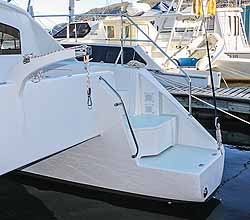 Pounce departed Valdivia fully provisioned and ready to sail non-stop the 3000 miles to Panama. Having me sign on at the last minute required a change in plans because I needed to get back to work and could only stay for a few days. There are only a few harbors along the bold coast of Chile and now it was time to gybe over in order to intersect the coast so I could get off.
Pounce departed Valdivia fully provisioned and ready to sail non-stop the 3000 miles to Panama. Having me sign on at the last minute required a change in plans because I needed to get back to work and could only stay for a few days. There are only a few harbors along the bold coast of Chile and now it was time to gybe over in order to intersect the coast so I could get off.
We were about 100 miles offshore when we gybed to starboard. Still on a deep reach but with the main swell further behind we had a comfortable ride, making a steady 9 to 10 knots with occasional surfs higher. The wind gradually decreased and we unrolled all of the mizzen and re-trimmed both foils for speed.
We were headed toward the major port of Valparaiso and we raised the first lights about 10 pm. By midnight we were close into the mountainous coast and the prevailing SW wind was replaced by a light but cold land breeze. We sailed past the resort town of Vina del Mar and rounded up under the point of Higuerillas, just outside of the yacht club breakwater. What looked like a reasonable enough anchorage on the chart felt very exposed. It was also fairly deep and the anchor had only a so-so feel to it when pulled hard. But it was calm and we only would be there until daylight.
In the morning, after much needed coffee and breakfast we inspected as much of Pounce as we could see. After all it was her first sail of consequence and she was bounced around enough to warrant a good look over. There was some pretty serious chafe on both jib outhaul lines which was caused by a sharp edge on each clew block. That was quickly filed off smooth and should not cause further problems. There was also a bit of chafe on one of the foil rotation lines but again there was a hard edge that needed to be smoothed. That's all we could find wrong. A very good check up after a 500 mile sail.
From anchor it was a short motor to the dock where I departed and Pounce resumed her passage northward to the Panama Canal.
In addition to the sailing, spending a few days aboard gave me a chance to see the functionality of the interior layout. The A47 inside is very much like the interior of the A55 and A57. The space and utility of the A57 pilothouse is largely matched in the 10'shorter A47, a feature that many who see the boat immediately appreciate.
Forward in the pilothouse there is a fully functional inside steering station to starboard and a nav/comm center to port. Aft starboard, on the galley side, is a dining table adjacent to large opening windows. Aft to port is a sitting area similar to what I have aboard Javelin - still my favorite comfortable seat for a night watch. In sum the pilothouse works very well and is a great place to keep watch while sailing or to hang out when anchored.
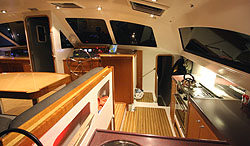 A new feature in the A47 is the galley configuration which is elevated and more integrated into the pilothouse than the A55/A57 layout. I like the way the A47 galley works, and the elimination of 3 steps down and 3 up every time you go into the galley is a nice plus. There is a spectacular view from the galley windows, which should help anyone prone to motion sickness keep their equilibrium.
A new feature in the A47 is the galley configuration which is elevated and more integrated into the pilothouse than the A55/A57 layout. I like the way the A47 galley works, and the elimination of 3 steps down and 3 up every time you go into the galley is a nice plus. There is a spectacular view from the galley windows, which should help anyone prone to motion sickness keep their equilibrium.
The midship cabins are a bit smaller in width than the A57 cabins, though the berths are the same size. There is ample storage space in this cabin.The heads and showers are just as functional as on the A57. The large inboard lockers that we find so useful on the A55/57 for sheets and towels as well as first aid and toiletry items are also similar.
The port aft cabin on the A47 is the most versatile and probably the best cabin on the boat. Three of the first four A47's have substantially different layouts in the aft cabin. There is a double bunk layout, a two single bunk layout and a two single bunk plus head layout. Seldom does a boat of this size offer so many alternatives.
Chris White


